Remembering the Hostages
In central Tel Aviv, crowds gather to lobby for the release of those kidnapped by Hamas
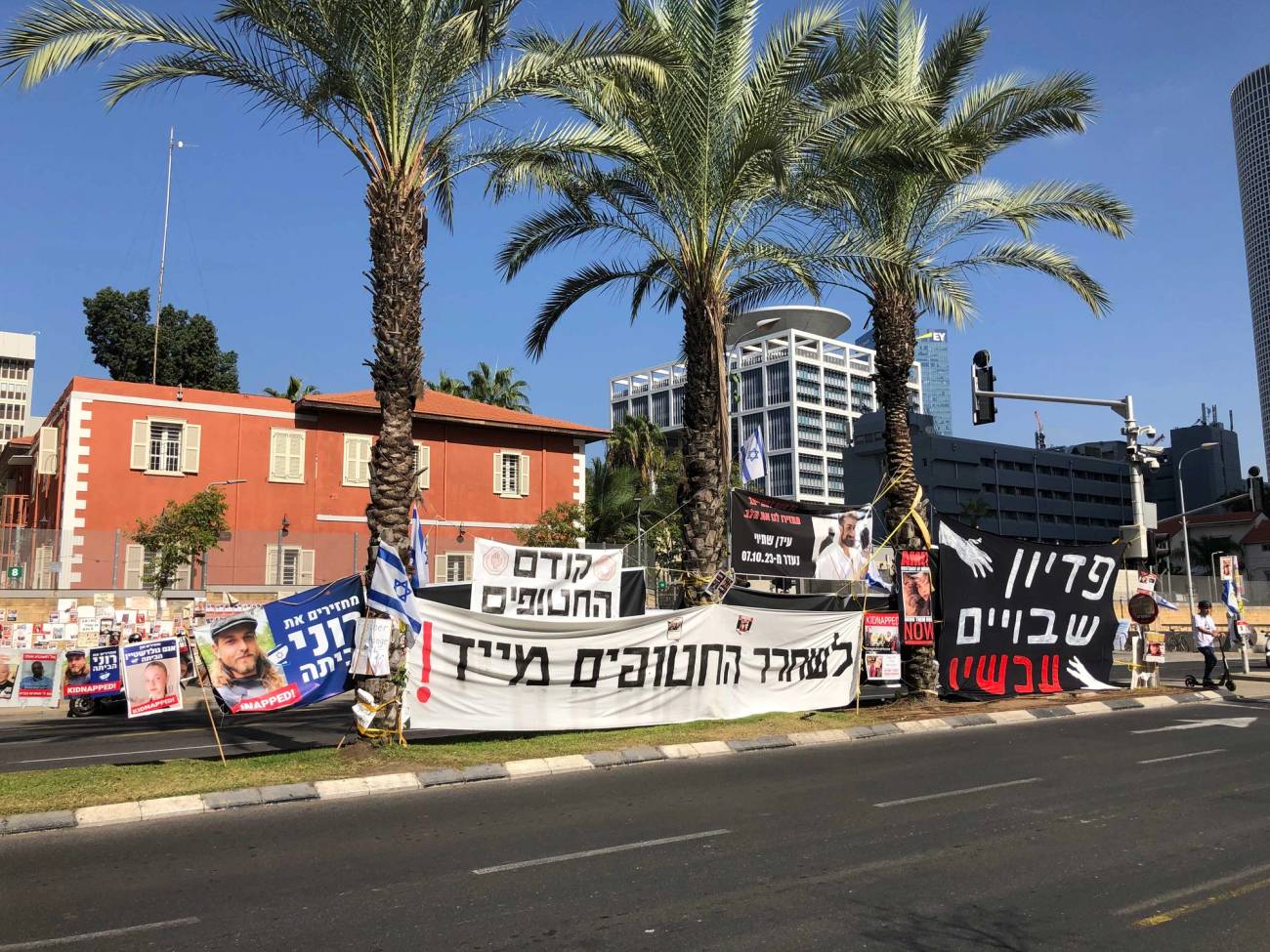
Courtesy of the author

Courtesy of the author

Courtesy of the author
The faces on 12”x18” placards stare out from seemingly everywhere in central Tel Aviv, as if cautioning passersby to consider, really internalize, each of the more than 240 individuals whom Hamas kidnapped on Oct. 7 and still holds captive in the Gaza Strip.
At an outdoor seating area of a restaurant in the Sarona Market complex, plates lay upon two tables on whose seats are taped placards showing Agam Goldstein, 17; Avraham Munder, 78; Yoram Metzger, 80; Erez Calderon, 12; Noa Argamani, 26; and Channa Peri, 79, as if the six Israelis await their meals.
A few steps away, five other people also seemed to sit and wait, at a bus stop fronting Kaplan Street: Romi Gonen, 23; Jonathan Samerano, 21; Shani Gabai, 25; Ron Sherman, 19; and Oron Shaul, 30. Shaul was killed in battle in 2014, with Hamas holding his body since then in Gaza. Bus No. 89 stopped. Together we’ll win read a message on its right side.
The placards all are black-bordered, with BRING HIM (or BRING HER) appearing prominently in white and HOME NOW! in red. Some say KIDNAPPED on top. All include QR codes to learn more about the individuals.
The captives’ images appear on Kaplan Street on concrete posts, metal security barriers, utility boxes, walls, and building facades. They’re on banners planted in the traffic island, scrawled on taped paper, and on the perimeter of the Kirya, the Defense Ministry, where pedestrians snap pictures of the placards and messages, defying posted warnings against photographing in that sensitive area. They project from the Azrieli Tower’s massive electronic billboard down the street.
Every minute counts reads a cardboard message secured by a yellow ribbon to a tree; yellow ribbons reading 7-10-23 #BringThemHomeNow are becoming as common a sight as the placards around town, too. Fuck Hamas is the message hanging at a slant below a traffic sign. Bring them home now, on a cardboard secured by a ribbon to a plastic chair. Save the children. A cracked heart. Home is empty without them. In Spanish: Our children hurt now. In German: Bring her home. In French: Do not leave me. In Japanese: Release the abducted people. Scores more in English and Hebrew: Bring our babies back. Redeeming of captives now. It could have been your family. Save the hostages to save Israel. Women’s lives matter. Who are we if they are there? He’s young/He’s just a little boy/Return him home in peace. Our hearts are with you, dear families of the abducted. On the sidewalk, a blue sticker: I want to go home; 7/10. Against a backdrop of painted red flowers: But to where did the children disappear?/Those I played with/Where are all the children?/Where are they all?/Who took them from me? At the center of a flyer headed Butterflies of hope, a QR code connects to instructions for making paper butterflies.
And this in black, spray-painted on the Defense Ministry’s perimeter wall, the most jarring of messages, attesting to the depravity-beyond-all-depravities during Hamas’ orgy of 1,200 murders and its rape and kidnapping and decapitation and arson and looting: Baby in the oven.
At a tent erected by the Maale Habsor School, people stopped by for commemorative stickers and yellow ribbons. It’s a school serving the now-evacuated kibbutzim in the Gaza Envelope region. Scores of its students, students’ parents, and staff were murdered and kidnapped on Oct. 7.
On another table, passersby picked up books of psalms and uttered a few. In a blue tarp-covered tent, a stuffed duck, Mickey Mouse, a red bear, a green monkey, and a teddy bear were tied to poles. From yellow tape hung some placards of children: Yuly Konio, 3; Avigail Idan, 3; Alma Or, 13; Gal Goldstein, 11; Tal Goldstein, 9; Noam Avigdori, 12; Ohad Munder Zachri, 9; Ela Elyakim, 8 1/2; Ariel Bibas, 4; Kfir Bibas, 9 months.
That’s where Menashe Bohbot stood, pressing stickers into the shirts and jackets of everyone walking by. No one objected. 10.7: The Day of Mourning, the stickers read. His family takes shifts here and at the city’s other site where loved ones of the kidnap victims congregate, just a few hundred yards away.
His cousin, Jerusalem resident Elkana Bohbot, 34, was working as a bartender at the trance music festival on Kibbutz Reim when Hamas kidnapped him. Menashe last saw Elkana a month prior.
“I want people to know we care about all of the captives,” said Bohbot, a retiree from Kiryat Gat. “I’m here 12 hours a day: 10 a.m. to 10 p.m. We’re demonstrating outside the Kirya so [Hamas] returns our kidnapped people intact and healthy.”
One person on whom Bohbot adhered a sticker was Omri Casspi, a Tel Avivian best known as the first Israeli to play in the National Basketball Association.
“We’re all together in this. We want them back. These savages took them,” said Casspi, who’s received supportive messages from NBA players, coaches, and owners. Some told him they’re praying for Israel.
He considered a question about the Israeli public’s embrace of the families.
“Obviously, keeping pressure on the political leaders to bring them back and to maintain the support of the world—this is what we’re focused on, for people to understand that babies are being held by terrorists,” he said. “This is a war crime.”
Casspi is using social media to keep attention on children Hamas kidnapped.
He turned his phone to show me Emilia Aloni, who was kidnapped with her mother Daniel from Kibbutz Nir Oz. Emilia, 5, “looks like my daughter a little,” he said.
“I can’t imagine what these kids are going through. Where do they eat? Where do they sleep?” Casspi said. “I pray for them.”
Around the corner, at a plaza fronting the Tel Aviv Museum of Art and the Beit Ariella Library on Shaul Hamelech (King Saul) Street, is the other, far larger center of the families and friends lobbying for their loved ones’ release from Hamas’ captivity. A street sign, wrapped in barbed wire, stands in the middle: The Hostages and Missing Square.
For an outdoor location downtown, the atmosphere is surprisingly subdued. It feels like a quiet vigil, almost a shiva house. People speak, but softly. There’s no vocal arguing or speechmaking. The tone is respectful. Snippets of conversations attest to the central topics at hand: people’s own turmoil, rumors of deals to release the captives, where a captive was that fateful day, the funerals, massive failures in preparedness and response on Oct. 7, the post-Oct. 7 anger at the government for its inattentiveness: its not picking up the pieces, not sending officials to extend comfort and information and empathy and encouragement.
But even those murmurs aren’t overtly anti-government, which, in politically charged Israel, says a lot. After all, the massive judicial-reform demonstrations occurred at the nearby Azrieli Tower.
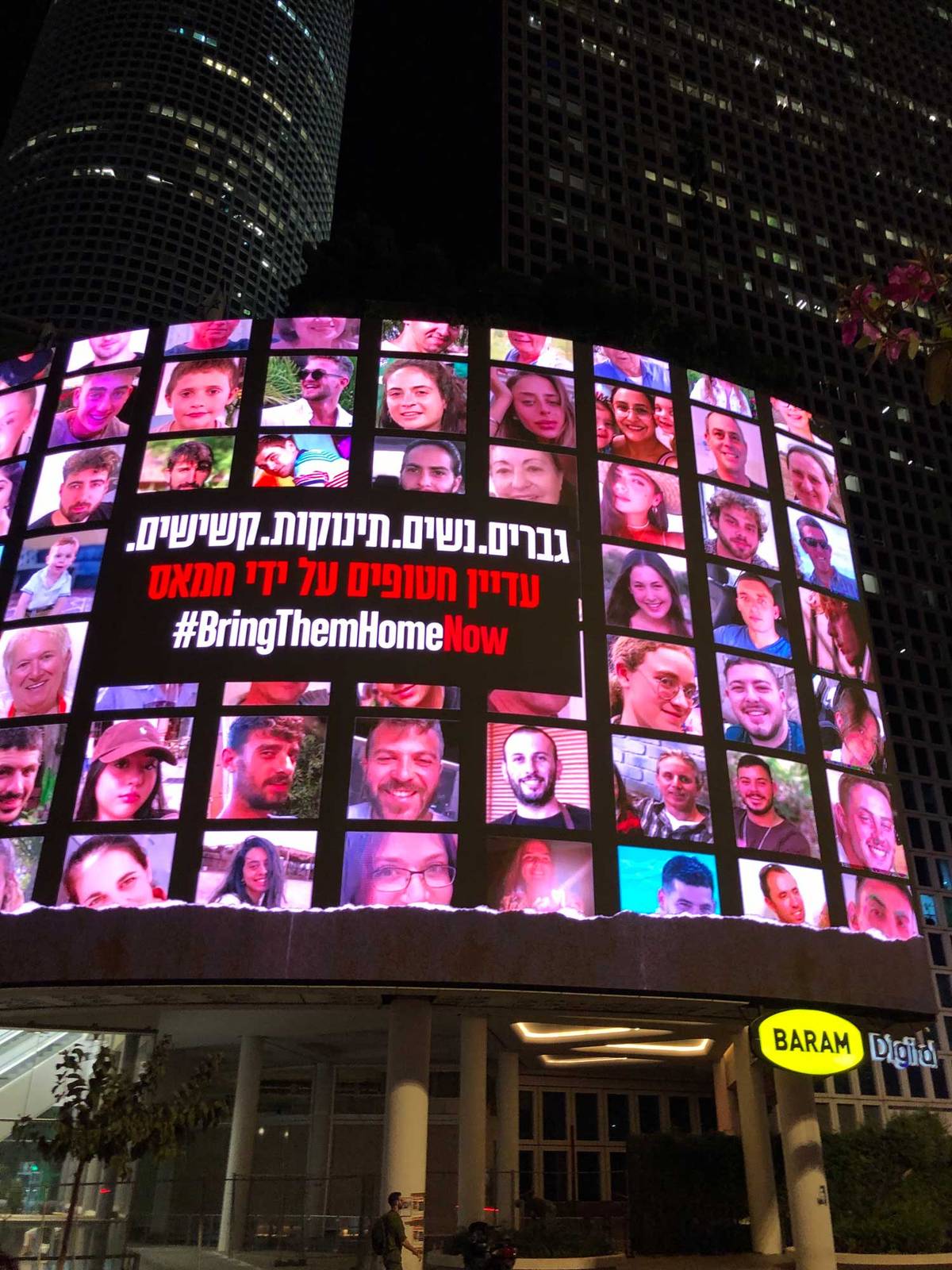
Courtesy the author
The plaza itself has become a quasi-museum to the nation’s ongoing trauma. It’s an obscene museum, really, in which stimulation abounds for the consumption of visitors, whose numbers grow as the workday ends. It’s also a vital support system for the families. Imagine their compounded pain were no one to stop by to listen, to absorb, to commiserate.
A small stage is where top performers appear most evenings. At the library’s steps, rabbinical students in the Conservative movement lead prayers and somber singing at nightfall. Placards and stickers and pictures are everywhere. A man in a golf cart sells Israeli flags and Am Yisrael Chai (the Jewish people live) posters. Someone at a table cuts yellow 7.10.23 ribbons for free distribution. Art evokes the kidnapping victims.
The captives’ loved ones are Exhibit A. Some members of Kibbutz Nachal Oz, one of the ravaged kibbutzim, and their supporters sat in an open white tent. In one of its corners, a box rested under a tree, and next to it blank paper and markers. A woman prompted visitors to write messages for the captives to read on this very spot when they’re liberated. One note reads: Our beloved people, how good that you’ve returned. You’re finally back, intact, in the heart of the country, and how wonderful that this day of your return has arrived. Another says: Romi Gonen, we’re waiting for you here. Come home now.
Anxiety pervades the plaza. So does hope. A military helicopter flew by, and a woman told her companion that maybe it dropped off a rescued captive at Ichilov Hospital a few blocks away.
“Who knows what’s happening behind closed doors?” she said.
The two were standing beside an arrangement of 7-foot-tall plastic flowers—purple, red, pink, and orange—springing from pads of synthetic grass. Eyal Raz created the display in tribute to the 30-plus kidnapped children, and he came on this day to check on it.
Raz, a resident of Jaffa, is a set designer. People aren’t in the mood to attend plays these days, so he applied his talent to the ongoing crisis. “Everyone has to make his own contribution. We’re in a situation of war,” Raz said, tightening a fish line holding placards of the children.
Flowers, like children, are “gentle, pure, special, beautiful, magical,” he said. The floral arrangement’s oval shape fosters “an energy,” he said, as visitors move to take in the faces.
Behind Raz runs perhaps the longest Shabbat table in the world, set with plates and silverware and challah and wine bottles and wine glasses—a yellow ribbon tied to each—and plants and even bowls of chewy candy. Every few feet, secured to folding chairs, fly yellow balloons with handwritten messages, like We’re waiting for you at home and We miss you. On each plate: a teeny book of psalms. On each chair: a placard of not a face, but a silhouette; not a name, but a word: HOSTAGE.
Some of the seats are highchairs.
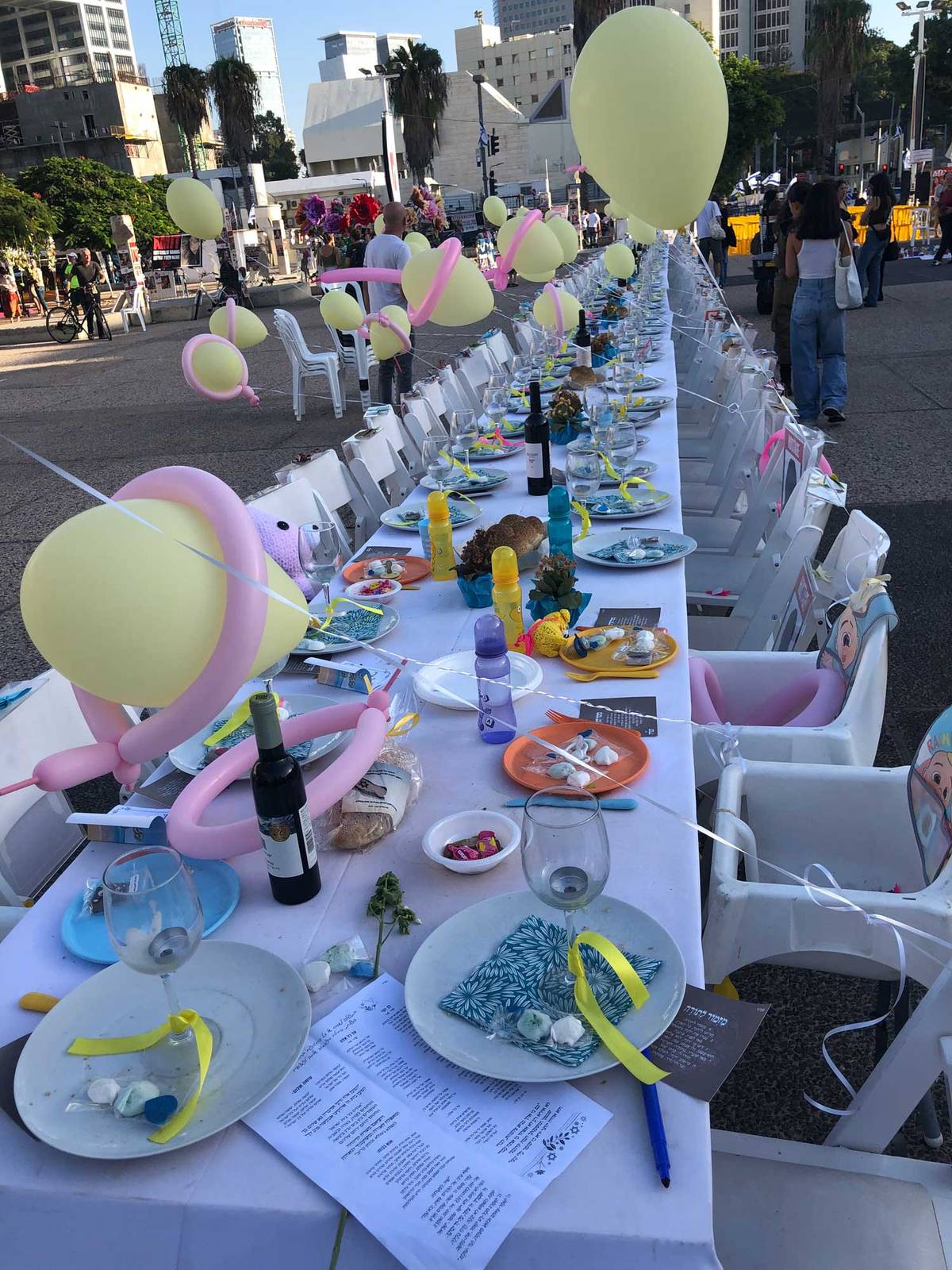
Courtesy the author
Art installations, at least eight, abound in the plaza. The art is raw: a girl mannequin wearing a red jumper, her head hidden within a black hood, standing in a granny cart, rope binding her extended hands to the cart, a bullseye behind her, and, on a plinth above, a briefcase with $100 bills sticking out to represent Qatar’s payments to Hamas that Israel had fostered. A uniformed female soldier cried as she looked at the exhibit, and a friend comforted her. Another installation: A rope leads into the top of a black barrel whose insides are lined with photos of captives, as the two hands of an unseen figure extend up from inches-deep sand in a bid to grasp the rope and reach safety. Time is running out. Immediate release! reads a printed sign at the top of the barrel. Another: a white sheet on the sidewalk, with black letters reading Awaiting you at home, on which visitors may write messages, and behind it several hundred models of houses, all hand-painted and bearing messages: Murder. We await you. Mom, I’m hungry. 7.10.23. Save us, Dad!! Now. Nova [the music festival].
The plaza’s core is a cluster of tents. Some captives’ families sleep in them. Other tents are symbolic and have names written at the top, or placards. Around the tents sit those most concerned with repatriating the captives. Sima S. clutched an 8”x10” photo of Itay Svirsky, 39, a Tel Aviv resident who on Oct. 6 returned to his childhood home on Kibbutz Be’eri to celebrate its 77th anniversary that night. He stayed with his mother. The next morning, Hamas kidnapped Itay and killed his parents, Orit and Rafi. Orit had founded the kibbutz’s art gallery. Her body was so badly burned that she wasn’t identified for two weeks. Her 97-year-old mother survived and attended the funerals of her daughter and ex-son-in-law. Her Filipino caregiver was murdered. Itay’s brother Yoni survived by hiding in a closet.
Sima remained friends with Rafi since serving together in the military more than a half-century ago. She comes to the plaza daily for a four-hour rotation. She has three goals, she said: to spread public awareness of Itay and the others, to continue equating Hamas with ISIS, and to press the International Red Cross to demand access to Hamas’ captives.
“It’s important,” she said.
Sitting opposite her, Sarina Chen explained that while she’s not directly connected to any victims, she feels bound to visit the plaza daily to speak with the families, to assure them they’re not alone.
“Our obligation as citizens of Israel is to be with them and support them,” she said. “It’s the obligation of Jews throughout the world.”
At 3 p.m. on Nov. 9, Alexander “Sasha” Troufanob’s friends and colleagues packed an office building’s patio on DaVinci Street, about midway between the families’ two centers, to salute his habit every workday at that moment of taking a coffee break.
Many of them were already at the building, working at the offices of the Hostages and Missing Families Forum, an all-volunteer initiative to press the captives’ cause through diplomacy, media, social media, publicity, and lobbying. The concept for the symbolic Shabbat table came from the forum’s creative team.
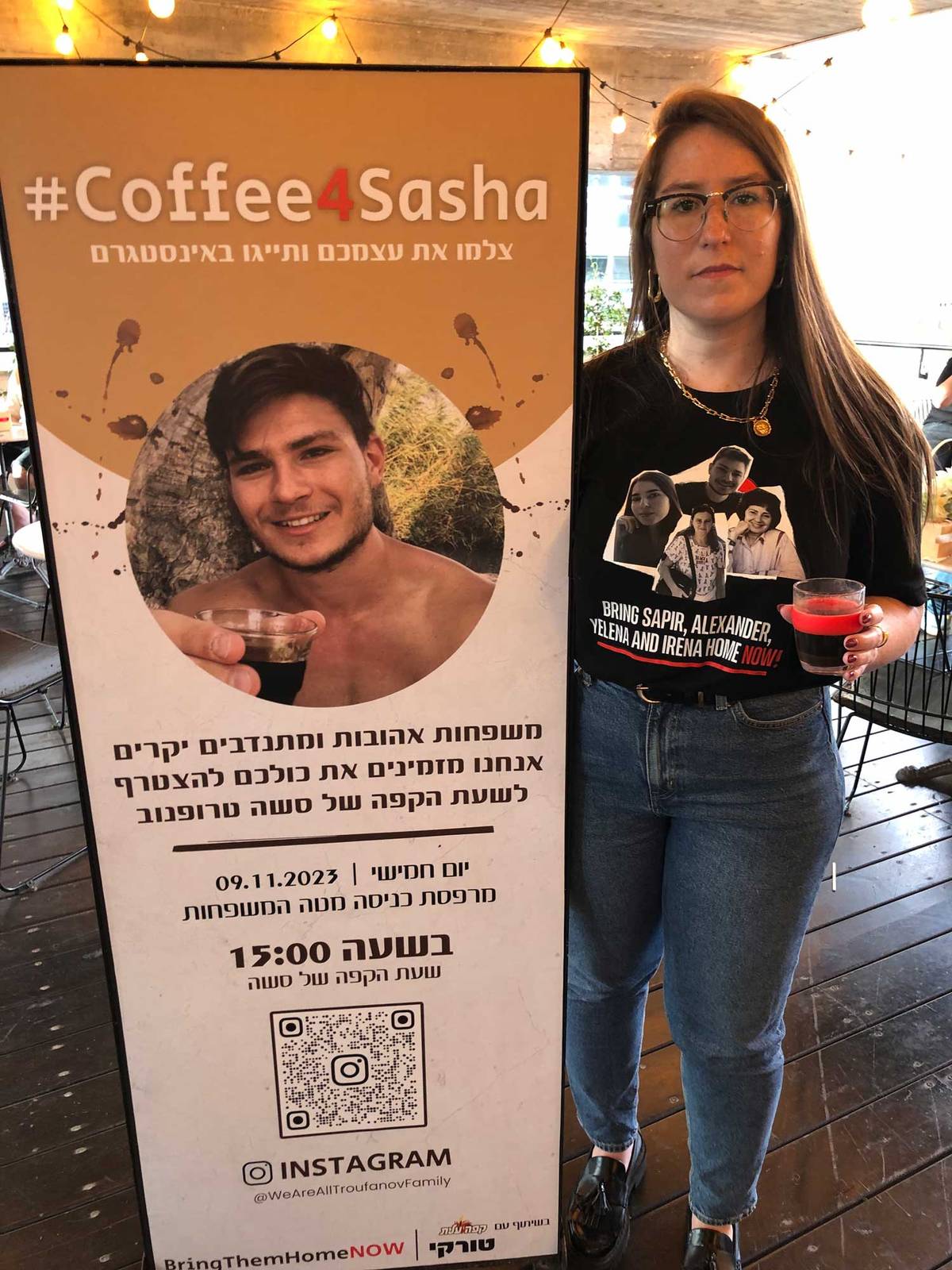
Courtesy the author
“The idea was to get a stronger connection between the families of those abducted and the international arena,” Barukh Binah, a retired Israeli diplomat, said of the department where he and other ex-envoys volunteer. “We have knowledge and we have connections.”
The diplomats’ outreach to foreign governments and communities isn’t coordinated with Israel’s Foreign Ministry, said Binah. “We just do what we think we should be doing.”
People pitch in, whatever the need. Meital Tarazi volunteers several nights a week after leaving work in the marketing department of a poultry company. At 7 p.m. on this night, she was getting the kitchen ready for dinner for the staff and some of the captives’ relatives.
She volunteers out of “a sense of guilt,” Tarazi said.
“How can it be that I wake up in the morning in my bed, eat, drink, and go to work, while some people experienced a Shoah?” she said. “I wanted to feel like I’m doing something. This is what I’m supposed to do.”
Down the hall, Ayelet Basel was in a storage room folding newly printed T-shirts in the movement’s colors of black, red, and white. Bring them home now! the front of the shirts read, with the forum’s name on the back.
“I’m looking to do physical work. It’s an outlet for my restlessness and energies,” she said. “I don’t have to think.
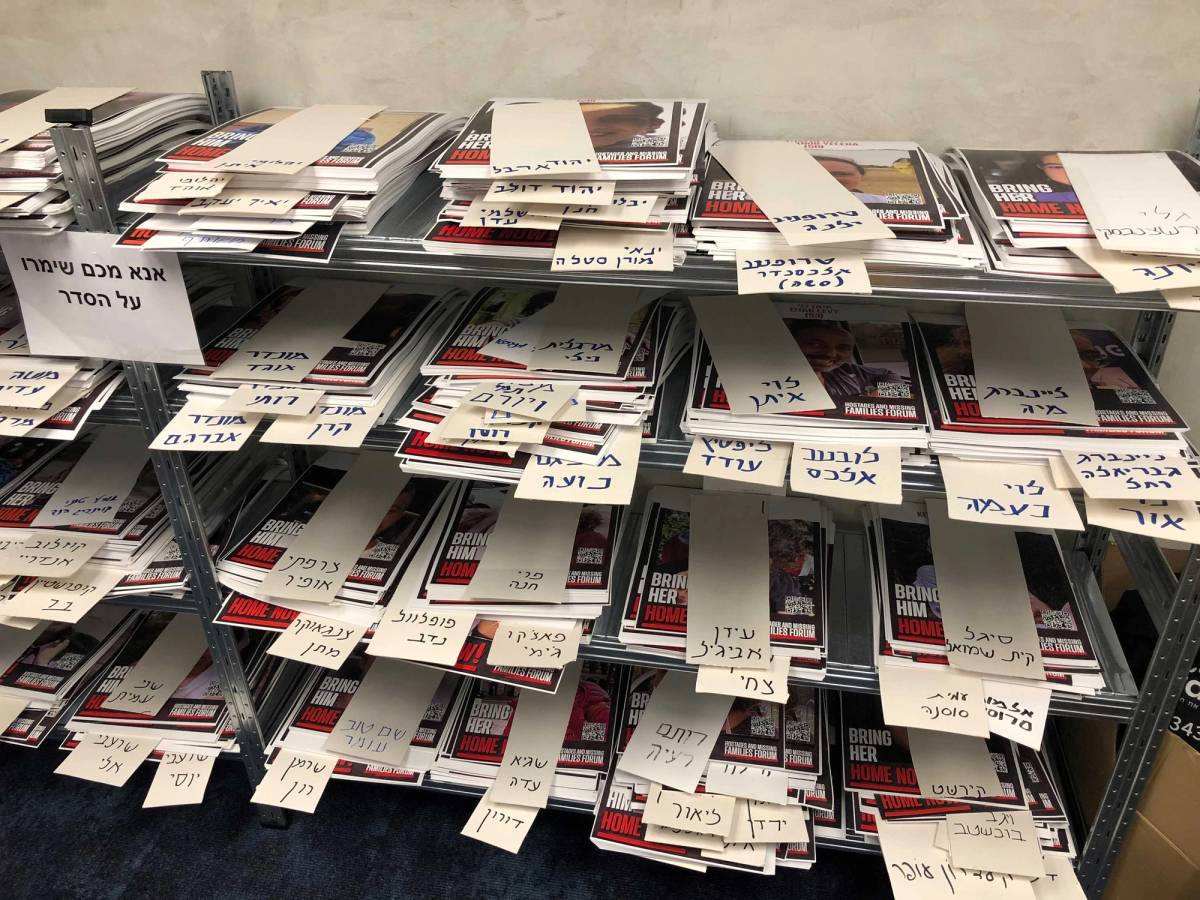
Courtesy the author
Around her, shelves hold the ubiquitous placards of most of the kidnapped, arranged alphabetically.
Fourteen names appeared on Basel’s list of posters to remove. They were considered kidnapping victims until Israel determined that they’d been killed.
“The hardest thing is to remove these posters because it’s counter to the hope that sustains us,” Basel said.
Troufanob’s friends are keeping the faith.
An engineer in the Tel Aviv office of Amazon, Troufanob would pull coworkers away from their computer screens to join him in the kitchen for some brew. He did it so likably that they happily agreed.
Their smiles are less common now. Hamas terrorists kidnapped Troufanob, his mother, Yelena, 50, his grandmother Irena Tati, 73, and his girlfriend Sapir Cohen, 29, from the family’s home on Kibbutz Nir Oz. They murdered his father, Vitali.
Troufanob’s brother lives in their native Russia, so the family has no relatives in Israel, which is why his circle of friends became the family’s advocates. Several took leaves of absence to work for the quartet’s release. They enlisted 100 technology professionals at other companies to commit to taking 3 p.m. coffee breaks in solidarity. They’ve met with ambassadors and spoken on Russian TV. They arranged for the Strauss food conglomerate, a major Israeli coffee distributor, to produce glass mugs and supply beverages and snacks for the Nov. 9 event. On the mugs’ packaging, Troufanob is shown grinning below the hashtag #Coffee4Sasha. A QR code connects to an Instagram account: We Are All Troufanob Family.
“We know that this energy will help him to be released,” said Shiri Grosbard, an Amazon colleague.
Grosbard saw one omen a few days earlier, when Yelena appeared in a video clip Hamas released.
“We know she’s healthy, she’s alive, and you can see that she’s sad,” Grosbard said.
Said Gal Fraktovnik, Troufanob’s classmate at Ben-Gurion University: “We are Sasha’s family in Israel. We are doing what a family would do.”
Three of Troufanob’s loved ones are stuck with him in Gaza, but his loved ones in Israel foresee a rousing welcome when freedom comes—“the biggest party,” Fraktovnik said. Nov. 11 was Troufanob’s 28th birthday. His adoptive family celebrated without him in Tel Aviv.
Fraktovnik joked that Troufanob, a private person who doesn’t keep social media accounts, would disapprove of the friends’ mobilizing publicity on his behalf.
“Whatever we have to do for him, we’ll do. Whatever can help, we won’t think twice,” she said. “When he returns, we’ll give him the biggest hug.”
She added: “That he should just return.”
Hillel Kuttler, a writer and editor, can be reached at [email protected].